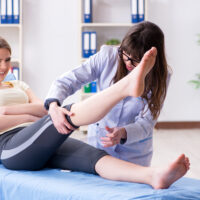Causes, Symptoms, and Management of Osteogenesis Imperfecta
Osteogenesis imperfecta (OI), also called brittle bone disease, causes children to be born with fragile, deformed bones. Such children are highly susceptible to fractures and bone breakage, even with slight movements or injuries. Approximately 25,000 to 50,000 kids in the country suffer from this condition. Although it has no specific cure, early diagnosis and adequate care can help manage the symptoms.

What causes osteogenesis imperfecta?
About 80% of cases are caused by autosomal dominant mutations in type 1 collagen genes COL1A1 and COL1A2. Simply put, these children either have highly insufficient or low-quality collagen. Since collagen provides bone structure, its absence or poor quality leads to bone deformity and the onset of osteogenesis imperfecta.
What are the symptoms?
Children born with this condition show various signs, some of which include:
- Deformed and brittle bones
Children with osteogenesis imperfecta have deformed and brittle bones. This is particularly the case with the longer bones in the body. - Frequent fractures
Bone brittleness typically causes fractures, even with slight falls or jerks. A study demonstrates that the forearm, lower leg, femur, and ankle are the most susceptible to fractures. - Stunted growth
Although the cause of this symptom is unclear, many children with the disorder are typically short-statured. Their heights are usually more than two standard deviations below the mean height for their age. - Weak muscles
Recent studies have found that patients may grapple with muscle weakness or reduced muscle mass besides suffering from bone brittleness. - Triangular face shape
Many children with osteogenesis imperfecta have triangular face structures due to bone deformity. It is often accompanied by a prominent frontal and protruding bi-temporal bone. - Tendinopathy
A lack of collagen affects not only one’s bones but also the skin, eyes, and tendons. Hence, children with the condition typically suffer from tendinopathy, characterized by tendon pain, swelling, and inflammation. - Restricted mobility
Patients have severe mobility issues due to bone and muscle weakness and tendon inflammation. Mobility problems may lead to severe pain and discomfort. - Ocular issues
As mentioned earlier, the condition may affect parts of one’s eyes. This can lead to ocular conditions like hyperopia (farsightedness), myopia (nearsightedness), blue sclera (blue pigmentation of the eyes’ white part, called sclera), glaucoma, and corneal rigidity. - Chest-wall deformities
Osteogenesis imperfecta may also involve deformities in the chest wall, leading to changes in the shape of one’s rib cage. Patients’ rib cages often resemble the shape of a barrel. - Osteosclerosis and hearing loss
Osteosclerosis is a disorder characterized by the hardening of one’s ear bone and an increase in its density. Many children suffer from osteosclerosis and related hearing loss. - Frequent bruising
Osteogenesis imperfecta patients may be more susceptible to injuries and bruising than others. Bleeding complications due to this condition have also been reported.
How is the condition treated?
As mentioned, osteogenesis imperfecta has no cure. However, healthcare experts recommend treatments to manage the symptoms and improve the child’s quality of life. A few common approaches are:
- Rodding
This procedure involves inserting a metal bar in the middle section of a bone to prevent its deformity. This bar is typically the length of the affected long bone. Rodding may help reduce the instances of fractures and injuries and prevent conditions like osteopenia. - Attending to fractures
Fractures due to osteogenesis imperfecta can aggravate mobility issues, pain, and discomfort. Hence, they should be treated immediately to prevent the symptoms from worsening. - Managing related health conditions
Treating health conditions caused by osteogenesis imperfecta, such as osteosclerosis and tendinopathy, can help manage its symptoms better and reduce its impact. - Physiotherapy
Physiotherapy can help strengthen one’s limbs and enhance overall muscle strength. However, since patients have extremely brittle bones, utmost care should be taken during these exercises. One should perform them under a professional’s supervision. - Use of assistive devices
Assistive devices like crutches, wheelchairs, and hearing aids (if needed) can help people with this condition manage mobility issues.
Are there any suitable remedies and lifestyle changes?
Patients can consider the following after consulting an expert:
- Eat calcium-rich foods
For stronger bones, patients should eat calcium-rich foods like dairy (if not lactose intolerant), salmon, soybeans, figs, and calcium-fortified foods. - Ensure sunlight exposure
The body requires vitamin D for optimal calcium absorption; therefore, patients should ensure adequate sunlight exposure besides eating calcium-rich foods. One can also consider vitamin D-rich foods like fatty fish, mushrooms, and fish liver oils. - Eat foods high in vitamin K
Vitamin K is another essential vitamin for bone and muscle strength. Patients should incorporate vitamin K-rich foods, like leafy green vegetables, canola oil, soybean, and cheese, into their meal plans. - Avoid a sedentary lifestyle
While mobility may cause restrictive movements, one should avoid being sedentary. Experts recommend using assistive devices like crutches to move about, at least within one’s home premises. - Get adequate sleep
A lack of night sleep is associated with weaker bones and low bone density. Patients with bone deformities should get eight hours of quality sleep every night to avoid further complications. Parents should ensure their children sleep on comfortable, supportive mattresses in a dark room without disturbance. - Social support
Social support plays an indispensable role in healing from osteogenesis imperfecta. Parents should be patient and warm toward their children if diagnosed with this disease. One must assist them in their daily activities while finding effective ways for them to lead independent lives. Teachers should also understand this condition and provide the necessary support to children at school.











